Vehicle armour
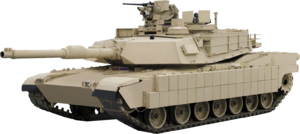
Military vehiclesare commonlyarmoured(or armored;see spelling differences) to withstand the impact ofshrapnel,bullets,shells,rockets,andmissiles,protecting the personnel inside from enemy fire. Such vehicles includearmoured fighting vehiclesliketanks,aircraft,andships.
Civilian vehicles may also be armoured. These vehicles include cars used byofficials(e.g.,presidential limousines),reportersand others in conflict zones or where violent crime is common. Civilianarmoured carsare also routinely used by security firms to carry money or valuables to reduce the risk ofhighwayrobberyor thehijackingof the cargo.
Armour may also be used in vehicles to protect from threats other than a deliberate attack. Somespacecraftare equipped with specialised armour to protect them against impacts frommicrometeoroidsor fragments ofspace debris.Modern aircraft powered byjet enginesusually have them fitted with a sort of armour in the form of anaramidcompositekevlarbandage around the fan casing or debris containment walls built into the casing of theirgas turbineengines to prevent injuries orairframedamage should the fan, compressor, orturbine bladesbreak free.[1]
Thedesignand purpose of the vehicle determines the amount of armour plating carried, as the plating is often very heavy and excessive amounts of armour restrict mobility. In order to decrease this problem, some new materials (nanomaterials) and material compositions are being researched which includebuckypaper,[2]andaluminium foamarmour plates.[3]
Materials[edit]
Metals[edit]
Steel[edit]
Rolled homogeneous armouris strong, hard, and tough (does not shatter when struck with a fast, hard blow). Steel with these characteristics are produced by processingcast steelbillets of appropriate size and then rolling them into plates of required thickness.[4]Rolling and forging (hammering the steel when it is red hot) irons out the grain structure in the steel, removing imperfections which would reduce the strength of the steel.[5]Rolling also elongates thegrain structurein the steel to form long lines, which enable the stress the steel is placed under when loaded to flow throughout the metal, and not be concentrated in one area.[6]
Aluminium[edit]

Aluminiumis used when light weight is a necessity. It is most commonly used onAPCsandarmoured cars.While certainly not the strongest metal, it is cheap, lightweight, and tough enough that it can serve as easy armour.
Iron[edit]
Wroughtironwas used onironclad warships.Early European iron armour consisted of 10 to 12.5 cm of wrought iron backed by up to one metre of solidwood.It has since been replaced by steel due to steel being significantly stronger.
Titanium[edit]
Titaniumhas almost twice the density of aluminium, but can have a yield strength similar to high strength steels, giving it a highspecific strength.It also has a high specific resilience and specific toughness. So, despite being more expensive, it finds an application in areas where weight is a concern, such aspersonal armourandmilitary aviation.Some notable examples of its use include theUSAFA-10 Thunderbolt IIand the Soviet/Russian-builtSukhoi Su-25ground-attack aircraft, utilising a bathtub-shaped titanium enclosure for the pilot, as well as the Soviet/RussianMil Mi-24attack helicopter.
Uranium[edit]
Because of its high density,depleted uraniumcan also be used in tank armour, sandwiched between sheets of steel armour plate. For instance, some late-productionM1A1HA and M1A2 Abramstanks built after 1998 have DU reinforcement as part of the armour plating in the front of the hull and the front of the turret, and there is a program to upgrade the rest (seeChobham armour).
Plastic[edit]
Plastic metalwas a type of vehicle armour originally developed formerchant shipsby theBritish Admiraltyin 1940. The original composition was described as 50% cleangraniteof half-inch size, 43% oflimestonemineral, and 7% ofbitumen.It was typically applied in a layer two inches thick and backed by half an inch ofsteel.
Plastic armour was highly effective at stoppingarmour piercing bulletsbecause the hard granite particles would deflect the bullet, which would then lodge between plastic armour and the steel backing plate. Plastic armour could be applied by pouring it into a cavity formed by the steel backing plate and a temporary wooden form.
Some main battle tank (MBT) armour utilises polymers, for example polyurethane as used in the "BDD" applique armour applied to modernizedT-62andT-55.
Glass[edit]
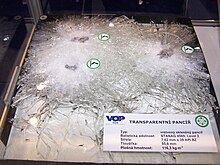
Bulletproof glassis a colloquial term forglassthat is particularly resistant to being penetrated when struck bybullets.The industry generally refers to it asbullet-resistant glassortransparent armour.
Bullet-resistant glass is usually constructed using a strong buttransparentmaterial such aspolycarbonatethermoplasticor by using layers oflaminated glass.The desired result is a material with the appearance and light-transmitting behaviour of standard glass, which offers varying degrees of protection fromsmall armsfire.
The polycarbonate layer, usually consisting of products such as Armormax,Makroclear,Cyrolon,Lexanor Tuffak, is often sandwiched between layers of regular glass. The use of plastic in the laminate provides impact-resistance, such as physical assault with a hammer, an axe, etc. The plastic provides little in the way of bullet-resistance. The glass, which is much harder than plastic, flattens the bullet and thereby prevents penetration. This type of bullet-resistant glass is usually 70–75 mm (2.8–3.0 in) thick.
Bullet-resistant glass constructed of laminated glass layers is built from glass sheets bonded together withpolyvinyl butyral,polyurethaneorethylene-vinyl acetate.This type of bullet-resistant glass has been in regular use oncombat vehiclessinceWorld War II;it is typically about 100–120 mm (3.9–4.7 in) thick and is usually extremely heavy.
Newer materials are being developed. One such,aluminium oxynitride,is much lighter but at US$10–15 per square inch is much more costly.
Ceramic[edit]
Ceramic's precise mechanism for defeatingHEATwas uncovered in the 1980s. High speed photography showed that the ceramic material shatters as the HEAT round penetrates, the highly energetic fragments destroying the geometry of the metal jet generated by thehollow charge,greatly diminishing the penetration. Ceramic layers can also be used as part of composite armour solutions. The high hardness of some ceramic materials serves as a disruptor that shatters and spreads thekinetic energyof projectiles.
Composite[edit]
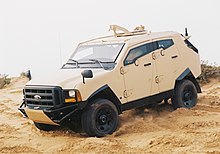
Composite armour is armour consisting of layers of two or more materials with significantly different physical properties;steelandceramicsare the most common types of material in composite armour.Compositearmour was initially developed in the 1940s, although it did not enter service until much later and the early examples are often ignored in the face of newer armour such asChobham armour.Composite armour's effectiveness depends on its composition and may be effective againstkinetic energy penetratorsas well asshaped chargemunitions;heavy metalsare sometimes included specifically for protection from kinetic energy penetrators.
Composite armour used on modern Western and Israeli main battle tanks largely consists of non-explosive reactive armour (NERA) elements - a type ofReactive armour.These elements are often a laminate consisting of two hard plates (usually high hardness steel) with some low density interlayer material between them. Upon impact, the interlayer swells and moves the plates, disrupting heat 'jets' and possibly degrading kinetic energy projectiles. Behind these elements will be some backing element designed to stop the degraded jet or projectile element, which may be of high hardness steel, or some composite of steel and ceramic or possibly uranium.
Soviet main battle tanks from theT-64onward utilised composite armour which often consisted of some low density filler between relatively thick steel plates or castings, for exampleCombination K.[7]For example, the T-64 turret had a layer of ceramic balls and aluminum sandwiched between layers of cast steel armour,[8]whilst some models of theT-72features a glass filler called "Kvartz". The tankglaciswas often a sandwich of steel and some low density filler, either textolite (afibreglassreinforced polymer) or ceramic plates.[9]Later T-80 and T-72 turrets contained NERA elements, similar to those discussed above.[10][11]
Ships[edit]

Belt armouris a layer of armour-plating outside thehull (watercraft)of warships, typically onbattleships,battlecruisers,cruisersand someaircraft carriers.[12]
Typically, the belt covers from the deck down someway below thewaterlineof the ship. If built within the hull, rather than forming the outer hull, it can be fitted at an inclined angle to improve the protection.
When struck by ashellortorpedo,the belt armour is designed to prevent penetration, by either being too thick for the warhead to penetrate, or sloped to a degree that would deflect either projectile. Often, the main belt armour was supplemented with atorpedo bulkheadspaced several metres behind the main belt, designed to maintain the ship's watertight integrity even if the main belt were penetrated.
The air-space between the belt and the hull also addsbuoyancy.Several wartime vessels had belt armour that was thinner or shallower than was desirable, to speed production and conserve resources.
Deck armouron aircraft carriers is usually at theflight decklevel, but on some early carriers was at thehangar deck.(Seearmoured flight deck.)
Aircraft[edit]
Armour plating is not common on aircraft, which generally rely on their speed and maneuverability to avoid attacks from enemy aircraft and ground fire, rather than trying to resist impacts. Additionally, any armour capable of stopping large-calibre anti-aircraft fire or missile fragments would result in an unacceptable weight penalty. So, only the vital parts of an aircraft, such as theejection seatand engines, are usually armoured. This is one area where titanium is used extensively as armour plating. For example, in the AmericanFairchild Republic A-10 Thunderbolt IIand the Soviet-builtSukhoi Su-25ground attack aircraft, as well as theMil Mi-24Hind ground-attack helicopter, the pilot sits in a titanium enclosure known as the "bathtub" for its shape. In addition, the windscreens of larger aircraft are generally made of impact-resistant,laminated materials,even on civilian craft, to prevent damage frombird strikesor other debris.
Armoured fighting vehicles[edit]
The most heavily armoured vehicles today are themain battle tanks,which are the spearhead of the ground forces, and are designed to withstandanti-tank guided missiles,kinetic energy penetrators,high-explosive anti-tankweapons,NBCthreats and in some tanks even steep-trajectory shells. TheIsraeliMerkavatanks were designed in a way that each tank component functions as added back-up armour to protect the crew. Outer armour is modular and enables quickly replacing damaged parts.
Layout[edit]
For efficiency, the heaviest armour on anarmoured fighting vehicle(AFV) is placed on its front. Tank tactics require the vehicle to always face the likely direction of enemy fire as much as possible, even indefenceorwithdrawaloperations.
Slopingand curving armour can both increase its protection. Given a fixed thickness of armour plate, a projectile striking at ananglemust penetrate more armour than one impactingperpendicularly.An angled surface also increases the chance of deflecting a projectile. This can be seen onv-hulldesigns, which direct the force of anImprovised explosive deviceorlandmineaway from the crew compartment, increasing crewsurvivability.[13]
Spall liners[edit]
Beginning during theCold War,many AFVs havespall linersinside of the armour, designed to protect crew and equipment inside from fragmentation (spalling) released from the impact of enemy shells, especiallyhigh-explosive squash headwarheads. Spall liners are made ofaramids(Kevlar,Twaron),UHMWPE(Dyneema,Spectra Shield), or similar materials.
Appliqué[edit]
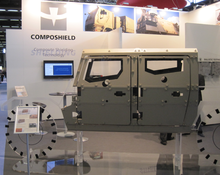
Appliqué armour,[14]or add-on armour, consists of extra plates mounted onto the hull or turret of an AFV. The plates can be made of any material and are designed to be retrofitted to an AFV to withstand weapons that can penetrate the original armour of the vehicle.[15][16] An advantage of appliqué armour is the possibility to tailor a vehicle's protection level to a specific threat scenario.
Improvised[edit]
Vehicle armour is sometimes improvised in the midst of an armed conflict by vehicle crews or individual units. InWorld War II,British, Canadian and Polish tank crews welded spare strips of tank track to the hulls of theirShermantanks.[17]U.S. tank crews often added sand bags in the hull and turrets on Sherman tanks, often in an elaborate cage made of girders. Some Sherman tanks were up-armoured in the field with glacis plates and other armour cut from knocked-out tanks to createImprovised Jumbos,named after the heavily armouredM4A3E2assault tank. In theVietnam War,U.S. "gun trucks"were armoured with sandbags and locally fabricatedsteelarmour plate.[18]More recently,U.S. troops in IraqarmouredHumveesand various military transport vehicles with scrap materials: this came to be known as "hillbilly armour"or" haji armour "by the Americans.[17]Moreover, there was theKilldozer incident,with the modified bulldozer being armoured with steel and concrete composite, which proved to be highly resistant to small arms.
Spaced[edit]

Armour with two or more plates spaced a distance apart, called spaced armour, has been in use since theFirst World War,where it was used on theSchneider CA1andSaint-Chamondtanks. Spaced armour can be advantageous in several situations. For example, it can reduce the effectiveness ofkinetic energy penetratorsbecause the interaction with each plate can cause the round to tumble, deflect, deform, or disintegrate. This effect can be enhanced when the armour issloped.Spaced armour can also offer increased protection againstHEATprojectiles. This occurs because theshaped chargewarhead can detonate prematurely (at the first surface), so that the metal jet that is produced loses its coherence before reaching the main armour and impacting over a broader area. Sometimes the interior surfaces of these hollow cavities are sloped, presenting angles to the anticipated path of the shaped charge's jet in order to further dissipate its power. Taken to the extreme, relatively thin armour plates, metal mesh, orslatted plates,much lighter than fully protective armour, can be attached as side skirts or turret skirts to provide additional protection against such weapons. This can be seen inmiddle and late-World War II German tanks,as well as many modernAFVs.Taken as a whole, spaced armour can provide significantly increased protection while saving weight.
The analogousWhipple shielduses the principle of spaced armour to protect spacecraft from the impacts of very fastmicrometeoroids.The impact with the first wall melts or breaks up the incoming particle, causing fragments to be spread over a wider area when striking the subsequent walls.
Sloped[edit]
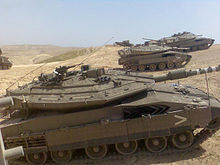
Sloped armour is armour that is mounted at a non-vertical and non-horizontal angle, typically on tanks and other armoured fighting vehicles. For a given normal to the surface of the armour, its plate thickness, increasing armour slope improves the armour's level of protection by increasing the thickness measured on a horizontal plane, while for a given area density of the armour the protection can be either increased or reduced by other sloping effects, depending on the armour materials used and the qualities of the projectile hitting it. The increased protection caused by increasing the slope while keeping the plate thickness constant, is due to a proportional increase of area density and thus mass, and thus offers no weight benefit. Therefore, the other possible effects of sloping, such as deflection, deforming and ricochet of a projectile, have been the reasons to apply sloped armour in armoured vehicles design. Another motive is the fact that sloping armour is a more efficient way of covering the necessary equipment since it encloses less volume with less material. The sharpest angles are usually seen on the frontal glacis plate, both as it is the hull side most likely to be hit and because there is more room to slope in the longitudinal direction of a vehicle.
Reactive[edit]

Explosive reactive armour,initially developed by German researcher Manfred Held while working in Israel, uses layers ofhigh explosivesandwiched between steel plates. When a shaped-charge warhead hits, the explosivedetonatesand pushes the steel plates into the warhead, disrupting the flow of the charge's liquid metal penetrator (usuallycopperat around 500 degrees Celsius;[citation needed]it can be made to flow like water by sufficient pressure). Traditional "light" ERA is less effective against kinetic penetrators. "Heavy" reactive armour, however, offers better protection. The only example currently in widespread service is RussianKontakt-5.Explosive reactive armour poses a threat to friendly troops near the vehicle.
Non-explosive reactive armouris an advanced spaced armour which uses materials which change their geometry so as to increase protection under the stress of impact.
Active protection systemsuse a sensor to detect an incoming projectile and explosively launch a counter-projectile into its path.
Slat[edit]
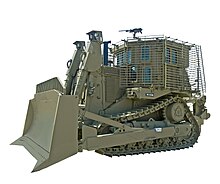
Slat armour is designed to protect againstanti-tankrocket and missile attacks, where the warhead is ashaped charge.The slats are spaced so that the warhead is either partially deformed before detonating, or the fuzing mechanism is damaged, thereby preventing detonation entirely. As shaped charges rely on very specific structure to create a jet of hot metal, any disruption to this structure greatly reduces the effectiveness of the warhead.[19]Slat armour can be defeated bytandem-chargedesigns such as theRPG-27andRPG-29.[20]
Electric armour[edit]
Electric armouris a recent development in theUnited Kingdomby theDefence Science and Technology Laboratory.[21][22][23][24][25][26][27]A vehicle is fitted with two thin shells, separated by insulating material. The outer shell holds an enormouselectric charge,while the inner shell is at ground. If an incoming HEAT jet penetrates the outer shell and forms a bridge between the shells, the electrical energy discharges through the jet, disrupting it. Trials have so far been extremely promising, and it is hoped that improved systems could protect against KE penetrators. The developers of theFuture Rapid Effect System(FRES) series of armoured vehicles are considering this technology.[citation needed]
See also[edit]
- Active protection system
- Armoured fighting vehicle
- Armoured forces
- Main battle tank
- Non-military armoured vehicles
- Personal armour
- Plastic armour
References[edit]
- ^"Containment Device: Transport Armor: Pinnacle Armor – Body Armor and Armoring Products".Pinnacle Armor. Archived fromthe originalon September 28, 2011.Retrieved2012-01-29.
- ^"Buckypaper armour".Slipperybrick. 2008-10-19.Archivedfrom the original on 2012-02-17.Retrieved2012-01-29.
- ^"Lightweight aluminum foam armour plates".Ntnu.no. Archived fromthe originalon 2012-09-05.Retrieved2012-01-29.
- ^Thomas, Daniel J. (October 2016)."Laser cut hole matrices in novel armour plate steel for appliqué battlefield vehicle protection".Defence Technology.12(5): 351–359.doi:10.1016/j.dt.2016.07.002.ISSN2214-9147.
- ^Administrator, System (2009-01-27)."Advanced armour steel".The Engineer.Retrieved2020-09-16.
- ^Thomas, Daniel J. (2016-10-01)."Laser cut hole matrices in novel armour plate steel for appliqué battlefield vehicle protection".Defence Technology.12(5): 351–359.doi:10.1016/j.dt.2016.07.002.ISSN2214-9147.
- ^Foss, Christopher F.,ed. (15 August 2005).Jane's Armour & Artillery, 2005-06(26th ed.). Janes Information Group. p. 102.ISBN978-0-7106-2686-8.
- ^Zaloga, Steven J. (21 July 2022).Tanks at the Iron Curtain 1960–75.Bloomsbury Publishing. p. 44.ISBN978-1-4728-4817-8.
- ^Warford, James M. (January–February 1998). Blakely, LTC Terry A.; Clemens, Jon T. (eds.)."Soviet-Russian Tank Turret Armor: The Cold War Shell-Game".Armor: The Professional Bulletin of the Armor Branch.CVII(1). U.S. Army Armor Center, 4401 Vine Grove, Fort Knox, KY 40121: U.S. Armor Association: 16–18.ISSN0004-2420.Retrieved1 October2023.
{{cite journal}}:CS1 maint: location (link) - ^"T80 Tank Characteristics".Military Analysis Network.Federation of American Scientists.Retrieved1 October2023.
- ^United States Marine Corps(1995).Soviet/Russian Armor and Artillery Design Practices: 1945-1995(Report). Quantico, VA: Marine Corps Intelligence Activity. pp. I-92−I-93.Retrieved1 October2023.
- ^those converted from other warships
- ^Katzman, Joe (2007-04-26)."In Praise of Senator Biden: Survivable Rides for the Troops".Winds of Change.NET. Archived fromthe originalon 2008-05-18.Retrieved2012-01-29.
- ^Oxford English Dictionary"appliqué,n.andadj:"Ornamental needlework in which small decorative pieces of fabric are sewn or stuck on to a fabric or garment to form a pattern or trim; the practice of this as a technique or activity; (also) (a piece of) decoration or trim made in this way. Also in extended use in metalwork, andfig".adj."Of fabric or a garment: decorated by sewing or sticking on small pieces of fabric to form a pattern or trim; (of decoration, trim, etc.) attached in this way".
- ^Gary W. CookeCombat Vehicle ProtectionArchived2009-02-04 at theWayback Machine1 August 2004. cites "FM 3-22.34 TOW Weapon System." and "FM 5-103 Survivability."
- ^US Patent 6962102 - Armour constructionsArchived2011-04-29 at theWayback MachineUS Patent Issued on November 8, 2005.PatentStormArchived2009-02-01 at theWayback Machine,Retrieved 2009-02-04
- ^abMoran, Michael."Frantically, the Army tries to armour Humvees: Soft-skinned workhorses turning into death traps,"MSNBC,April 15, 2004.
- ^Gardiner, Paul S."Gun Trucks: Genuine Examples of American Ingenuity,"Archived2007-11-02 at theWayback MachineArmy Logistician,PB 700-03-4, Vol. 35, No. 4, July–August 2003, Army Combined Arms Support Command, Fort Lee, Virginia.ISSN0004-2528
- ^"Slat Armour for Stryker".Defense-Update. 2006. Archived fromthe originalon 2012-01-30.Retrieved2012-01-29.
- ^"BAE's LROD Cage Armor".Defense Industry Daily. 2011-03-15.Archivedfrom the original on 2012-01-29.Retrieved2012-01-29.
- ^U.S. Military Uses the ForceArchived2013-04-09 at theWayback Machine(Wired News)
- ^'Star Trek' shields to protect supertanksArchived2008-01-04 at theWayback Machine(The Guardian)
- ^"'Electric armour' vaporises anti-tank grenades and shells ".Archived fromthe originalon 2008-04-23.Retrieved2018-11-18.
- ^MoD Develops 'Electric Armour'ArchivedFebruary 17, 2008, at theWayback Machine
- ^"New Age Electric Armour – Tough enough to face modern threats".Armedforces-int. Archived fromthe originalon 2009-05-02.Retrieved2012-01-29.
- ^"Add-On – Reactive Armor Suits".Defense-Update. 2006-04-25. Archived fromthe originalon 2012-01-26.Retrieved2012-01-29.
- ^"Advanced Add-on Armor for Light Vehicles".Defense-Update. 2006-04-25. Archived fromthe originalon Apr 1, 2018.Retrieved2012-01-29.
